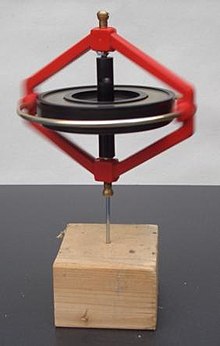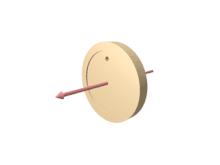Gyroscope
A gyroscope , also known as a gyro stabilizer or gyroscope ( Greek γύρος gyros , German 'rotation' and σκοπεῖν skopein 'see'), is a rapidly rotating, symmetrical top that turns in a movable bearing. The bearing can be a cardanic suspension or a frame in the form of a cage (see illustration). Due to the conservation of angular momentum , the gyroscope has a high degree of inertia with regard to changes in position in space. If the speed of rotation between the top and the cage is measured, it is called a gyrometer . Gyroscopes are used as navigation instruments and for active attitude control, especially in the aerospace industry. The attitude control of spacecraft such as satellites makes use of the fact that the overall system of spacecraft and gyroscope maintains its angular momentum and thus the position can be controlled by transmitting angular momentum between the two.
The term gyro or gyro is currently used in a transposing manner for a large number of rotation rate sensors that do not contain any gyros, but fulfill the same purpose as an actual gyro instrument.
history
The gyroscope - today the terms gyroscope and gyro compass are used synonymously - was invented in 1810 by the professor of physics , mathematics and astronomy Johann Gottlieb Friedrich von Bohnenberger at the University of Tübingen ; a copy was first rediscovered in 2004 by Alfons Renz, private lecturer at the Biological Faculty of the Eberhard Karls University in Tübingen, in the Kepler-Gymnasium Tübingen. In 1852 Léon Foucault developed the gyroscope up to the design and manufacture of the gyrocompass, whereby the first gyroscope from 1810 is indistinguishable as an idea and was an essential basis for the invention of the gyrocompass in 1852.
Physical principles
A gyroscopic system can be seen as a closed system whose angular momentum remains constant. If an external force tries to tilt the axis of rotation of the gyroscope, a torque perpendicular to the force results , to which the angular momentum strives to adjust according to the rule of parallelism in the same direction . The angular momentum tilts perpendicular to the acting force. The axis of rotation is coupled to the angular momentum via the inertia tensor , which is why the gyro axis follows the angular momentum and revolves around it on a narrow cone, see twist stabilization . The effect is known, among other things, from the toy top, the axis of which precesses along a cone shell due to the force of gravity trying to tilt it . With a symmetrical top, the opening angle of the cone is inversely proportional to the square of the speed and the ratio of the axial to the equatorial main moment of inertia of the top.
Measurement principles
The following measuring principles are therefore possible on the gyro :
- The stability of the gyro axis : A free-running, symmetrical gyro strives to maintain the direction of its axis of rotation in the inertial space. - A reference to the situation is given
- The precession : If an external force tries to change the direction of the axis of a running top, the top axis does not follow the direction of application of this force, but deviates at right angles to it in the sense of the rotation of the top. - External force and precession are directly related, a change in position becomes measurable
The two laws are the basis of all gyro instruments: The first sentence is a consequence of inertia , the second set of a series of swirl set (set of angular momentum) .
In a closed system in addition to the total remains pulse and the angular momentum obtained. Stability and precession increase with the angular momentum of the top.
The effect is also referred to as a directional top; important technical applications are the artificial horizon and the course top in aviation. In practice, every smallest imbalance causes the gyro axis to slowly migrate (gyro drift ), which can be more or less reduced by certain measures.
Precession is used on an even wider scale: u. a. as a manipulated variable for tasks of mechanical stabilization, for the gyrocompass of nautical science or for the surveying gyro ( direction- seeking or north-looking gyro), or for instrument flight with the turning pointer .
Technical applications
Gyroscopic instruments are widely used in traffic engineering , especially for orientation and navigation .
- In cars , gyrometers can measure changes in direction more precisely than is possible using the wheel position. Together with the measurement of the distance traveled, it is possible to determine the position very precisely ( dead reckoning ), which in some GPS navigation systems already continues to display when the satellite signals (e.g. in a tunnel) fail. These usually contain a vibrating top .
- Gyroscope sensors are included in many smartphones and tablets . They are also used here for further navigation if the GPS system has failed. But they are also used for game apps (e.g. for moving figures).
In any gyro system, however, every small imbalance would lead to an increasing gyro drift over longer periods of time , which would be very disruptive, especially in aviation. Therefore, magnet-based gyrosyn devices are being developed, which stabilize the direction measurement over a longer period of time.
- As a rule, there are several gyroscopic instruments in every aircraft cockpit :
- The artificial horizon shows the pilot a line that is aligned horizontally before take-off. During the flight, the horizon gyro keeps this line in the horizontal due to its axis stability, even if the aircraft is leaning forwards, backwards or to the side. This allows you to determine the spatial position of the aircraft in the cockpit, even if darkness, clouds or centrifugal forces caused by flight path make direct visual orientation difficult (see instrument flight )
- The turning pointer enables precisely controlled turn .
- The course gyro enables the direction of flight to be maintained.
- Further gyro systems are located in the aircraft fuselage and are usually combined there to form an INS (inertial navigation). These are used to control the autopilot and to display position and direction deviations on the computer monitors in the cockpit.
- Gyroscopic instruments in combat ships or tanks enable the guns to be precisely aligned with the targeted targets despite the swell or uneven terrain.
Position control is also important in other areas (whereby the gyroscope can also stand for rotation rate sensors, which are not actually based on gyroscopes):
- For railway cars with tilting technology, gyroscopes supply the sensor data for comfort control.
- In model airplanes and helicopters , gyroscopes are used to stabilize one or more axes against wind or against side effects of the control, because otherwise these are difficult to control. In the beginning, mechanical gyroscopes were used, now piezo or SMM sensors (Silicon Micro Machine) are used; In both cases, the control corrections are calculated directly in the flight model via integrated microcontrollers .
- On aircraft carriers , a gyroscopically mounted construction is also used to stabilize the approach guidance beam so that the wave movements of the ship are not transferred to the beam.
- Torpedoes or unmanned aerial vehicles such as B. Ballistic missiles do not require an artificial horizon. Instead, a gyro instrument is connected directly to the control, which first happened with the A4 (V2 rocket) during World War II. The gyro control is used to compensate for undesired influences such as drift due to wind or irregularities in the drive in order to maintain the programmed flight path. Today it is mostly part of an inertial navigation system (INS).
- In space travel , gyroscopes are used for position control: Here the inertia wheel and the reaction wheel stabilize themselves in an almost force-free space . Metrological aspects only play a secondary role. The most precise and technically sophisticated gyro instrument to date was designed for the Gravity Probe satellite launched in April 2004 , the first results of which were announced in April 2007.
- Gyroscopes are also used in gyro-stabilized binoculars , in which the gyroscope instrument enables observation from speed boats or from helicopters or motor vehicles.
- The BMW S 1000 RR also uses two gyroscopes to use Dynamic Traction Control (DTC for short).
- In 2009, gyroscopes in Nintendo's expansion Wii Motion Plus were first used in the entertainment industry.
- The " PlayStation 3 Move Controller " also uses a gyroscopic sensor.
- As early as the 1970s, the cameraman Jost Vacano developed the so-called 'Joosticam', a kind of steadicam with which he also filmed the film Das Boot . This technology has recently been used in the on-board camera in the FIM motorcycle world championship and was first used at the Sachsenring on Valentino Rossi's motorcycle.
See also
- Gyroscopic effect
- for so-called optical gyroscopes: laser gyro
- In aviation: course gyro , turn indicator , artificial horizon
literature
- Nina Fedorovna Babajewa: gyroscopes (Original title: Giroskopy translated by Volker Christoph). Military publishing house of the German Democratic Republic, Berlin 1975.
- Wolf von Fabeck: gyroscopic devices , the different types of devices and their technical applications, principle-related errors and technical solutions, physical principles. Vogel, Würzburg 1980, ISBN 3-8023-0612-0 (Chapters 1, 3 and 8).
- Alfons Renz: Bohnenberger's gyroscope. A typical Tübingen invention . In: Tübinger Blätter 93 (2007), pp. 27–34.
- Harro Simon: Instrument Aviation and Navigation , Part I, Books of Aviation Practice , Volume 8. Reich, Munich 1961.
- Jörg F. Wagner, Helmut Sorg, Alfons Renz: The machine of Bohnenberger . In: GeoBit , 10, 2005, 4 GIS, pp. 19-24.
- Jörg F. Wagner, Helmut Sorg, Alfons Renz: The machine of Bohnenberger . In: European journal of navigation . The leading journal for systems, services and applications, Vol. 3, 2005, 4, pp. 69-77.
Web links
- Gyroscopic laws . (PDF, 287 kB) Basic physics internship, Univ.Jena
- Roundabout laws on stationary and hanging roundabouts ( memento from September 23, 2013 in the Internet Archive ) (with images)
- Stanford University report on the Gravity Probe instrument
- Video about gyroscopically stabilized CD players in weightlessness
- Detailed site about gyroscopes (English)
Individual evidence
- ↑ Jörg F. Wagner; Helmut Sorg; Alfons Renz: The machine of Bohnenberger . In: GeoBit 10 (2005), 4 GIS, pp. 19-24; Jörg F. Wagner; Helmut Sorg; Alfons Renz: The machine of Bohnenberger . In: European journal of navigation. The leading journal for systems, services and applications, Vol. 3 (2005), 4, pp. 69-77; Alfons Renz: Bohnenberger's gyroscope. A typical Tübingen invention . In: Tübinger Blätter 93 (2007), pp. 27–34.
- ↑ Harro Simon: Instrument Aviation and Navigation. Part 1. Basics and training in powered and glider flight . In: Books of Aviation Practice . tape 8 . Reich, 1961.


